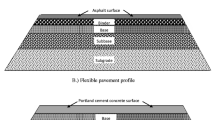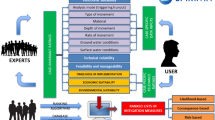Abstract
A new comprehensive, web-based information system summarizes forty-six geoconstruction technologies, or ground improvement methods, applicable to transportation infrastructure from the following areas: geosynthetics, geotextiles, ground improvement, grouting, slope stabilization, soil reinforcement, soil stabilization, and alternative/recycled materials. Selection assistance was developed as part of the overall information system to aid the user in identifying potential geoconstruction technologies for a project-specific set of conditions. A knowledge base to assist a user in evaluating the current status of each technology with regard to the U.S. practice and the potential applications for each technology is described in detail. Selection assistance includes qualitative ratings for each technology, a listing of the technologies sorted by classification or desired improvement, and a dynamic, Interactive Selection tool. After assisting the user in identifying a short list of potential technologies, the user can access the technology specific data in the information system to further evaluate the technologies. Engineers, planners, and owners will be able to utilize the entire information system to assess the feasibility of technologies to address project-specific requirements and constraints.







Similar content being viewed by others
References
ASCE (1978) Soil improvement-history, capabilities, and outlook. In: Mitchell JK (ed). ASCE, New York
ASCE (1987) Soil improvement—a ten year update. In: Welsh JP (ed). Geotech. Spec. Publ. No. 12, ASCE, New York
ASCE (1997) Ground improvement, ground treatment, ground reinforcement-developments 1987–1997. In: Schaefer VR (ed). Geotech. Special Publication No. 69, ASCE, New York
Chameau RL, Santamarina JC (1989) Knowledge-based system for soil improvement. J Comput Civil Eng 3(3):253–267
Charles JA, Watts, KS (2002) Treated ground—engineering properties and performance. CIRIA C572, London
Cheng M-Y, Tsai H-C, Ko C-H, Chang W-T (2008) Evolutionary fuzzy neural inference system for decision making in geotechnical engineering. J Comput Civil Eng 22(4):272–280
Chu J, Varaksin S, Klotz U, Menge P (2009) Construction processes, state of the art report. 17th international conference on soil mechanics and geotechnical engineering. Alexandria, Egypt, 5–9 Oct 2009
Douglas SC, Schaefer VR, Berg RR (2012) Web-based information and guidance system development report—SHRP 2 R02 project. Report prepared for the Strategic Highway Research Program 2, February
Elias V, Welsh J, Warren J, Lukas R, Collin JG, Berg RR (2006) Ground improvement methods. FHWA NHI-06-019 (vol 1) and FHWA NHI-06-020 (vol 2), Washington, DC
Fredlund MD, Sillers WS, Fredlund DG, Wilson GW (1996) Design of a knowledge-based system for unsaturated soil properties. 3rd Canadian conference on computing in civil and building engineering. Montreal, Quebec, 26–28 Aug
Holtz RD (1989) Treatment of problem foundations for highway embankments. National cooperative highway research report 147, Synthesis of highway practice. Transportation Research Board of the National Academies, Washington, DC
Hopple GW (1998) The state-of-the-art in decision support systems. QED Information Sciences, Wellesley, MA
Ignizio JP (1991) Introduction to expert systems: the development and implementation of rule-based expert systems. McGraw-Hill, New York
Jackson P (1999) Introduction to expert systems, 3rd edn. Addison Wesley Longman, Essex
Mitchell JK (1981) Soil improvement: state-of-the-art. Proceedings of tenth international conference on soil mechanics and foundation engineering. Stockholm, Sweden, vol 4, pp 509–565, June
Motamed F, Salazar G, D’Andrea R (1991) An expert system for preliminary ground improvement selection. Geotechnical engineering congress 1991, vol I. ASCE, New York, pp 379-390
Munfakh GA, Wyllie DC (2000) Ground improvement engineering—issues and selection. GeoEng 2000, 19–24 Nov 2000, Melbourne, Australia, vol 1: invited papers. Technomic, Lancaster, PA, pp 333–359
Naik K, Tripathy P (2008) Software testing and quality assurance, theory and practice. Wiley, New Jersey
Sadek S, Khoury G (2000) Soil and site improvement guide: an educational tool for engineered ground modification. Int J Eng Educ 16(6):499–508
Spring GS, Collura J, Shuldiner PW, Watson J (1991) Testing, verification, and validation of expert systems. J Transp Eng 117(3):350–360
Terashi M, Juran I (2000) ground improvement—state of the art. GeoEng 2000, 19–24 Nov 2000, Melbourne, Australia, vol 1. Technomic, Lancaster, PA, pp 461–519
USACE (1999) Guidelines on ground improvement for structures and facilities. Technical Letter No. 1110-1-185. Department of the Army. U.S. Army Corps of Engineers, Washington, D.C., February
Acknowledgments
The authors gratefully acknowledge the efforts of their colleagues on the research team: Donald Bruce, Barry Christopher, Jim Collin, Gary Fick, George Filz, Jie Han, James Mitchell, Dennis Turner, Linbing Wang, and David White, who served as co-principal investigators on the SHRP 2 R02 project. A number of students/researchers from Iowa State University, Virginia Tech and the University of Kansas contributed to the development of the materials for the project and their efforts are greatly appreciated. The members of the SHRP 2 R02 Advisory Board provided invaluable advice during the project. This study was funded by the Strategic Highway Research Program 2 of The National Academies, with Dr. James Bryant as program manager. The opinions, findings and conclusions presented here are those of the authors and do not necessarily reflect those of the research sponsor.
Author information
Authors and Affiliations
Corresponding author
Electronic supplementary material
Below is the link to the electronic supplementary material.
Rights and permissions
About this article
Cite this article
Douglas, S.C., Schaefer, V.R. & Berg, R.R. Selection Assistance for the Evaluation of Geoconstruction Technologies for Transportation Applications. Geotech Geol Eng 30, 1231–1247 (2012). https://doi.org/10.1007/s10706-012-9534-1
Received:
Accepted:
Published:
Issue Date:
DOI: https://doi.org/10.1007/s10706-012-9534-1




